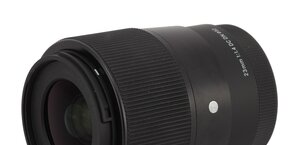Sigma C 28-70 mm f/2.8 DG DN
4. Image resolution
Let’s check how the tested Sigma C 28-70 mm f/2.8 DG DN compares here. A graph below presents the results in the frame centre, at 28, 50, and 70 mm focal lengths.

Please Support UsIf you enjoy our reviews and articles, and you want us to continue our work please, support our website by donating through PayPal. The funds are going to be used for paying our editorial team, renting servers, and equipping our testing studio; only that way we will be able to continue providing you interesting content for free. |
- - - - - - - - - - - - - - - - - - - - - - - - - - - - - - - - - - - - - - - - - - - - - - - -
When it comes to the resolution at the shortest focal length the results are excellent up from the maximum relative aperture where the lens is able to exceed a very high level of 70 lpmm. With the increase of the focal length the results get down but it would be difficult to complain. Even at the maximum relative aperture the lens is able to exceed the decency level and on stopping down the aperture it reaches a very high level near 70 mm.
Still you have to notice the fact that in this area the rival Tamron 28-75 mm f/2.8 Di III VXD G2 performed better – its maximum results are higher and, additionally, it featured smaller differences between particular focal lengths.
Now let's check the situation on the edge of the APS-C sensor, an appropriate graph you can find below.

Here the differences between particular focal lengths are smaller and the middle of the focal range sticks out. At the maximum relative aperture, no matter what focal length you employ, you always land above 40 lpmm and on stopping down the aperture the MTFs can reach even a very good level of almost 60 lpmm. As you see there are no reasons to complain but, once again, the Tamron performed here a tad better, especially at the shorter end of the focal spectrum.
What about the performance on the very demanding edge of full frame? Let's find out.

Here the much smaller dimensions of the Sigma, compared to the dimensions of the Tamron, make themselves felt. There are no reservations concerning only the 50 mm focal length because image quality remains completely useful even at the maximum relative aperture. The ends of the range fare weaker and they offer you an acceptable resolution level only after stopping down of the lens to near f/4.0. It's worth noticing that the 28 mm focal length reacts much better on stopping down so near f/5.6 and f/8.0 you can get MTFs on a very good level of 55 lpmm. It is a very sensible approach because the wide angle is going to be used more often when it comes to landscape photography and architecture photography, where you care about good image quality across the frame.
It's interesting that, even though the Sigma's 70 mm focal length fares the weakest on the edge of full frame, it still remains better than the same focal length of the Tamron.
To sum up the Sigma C 28-70 mm f/2.8 DG DN doesn't provide you the slightest reasons to complain when it comes to the performance in the frame centre and on the edge of the APS-C sensor. Its small dimensions and weight joined with the good f/2.8 fixed aperture forced some compromises and they are visible on the very edge of full frame; fortunately it is true just at the very ends of the focal range and only near the f/2.8 aperture.
At the end of this chapter we present crops taken from our testing image in the frame centre. It’s worth remembering that those are JPEG files saved along RAW files, used for the analysis presented above.
| A7R IIIa, JPEG, 28 mm, f/4.0 |
 |
| A7R IIIa, JPEG, 70 mm, f/2.8 |
 |






